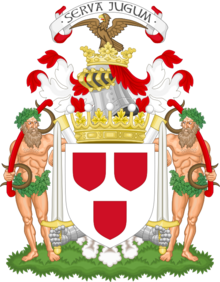Lord Hay
| Earldom of Erroll | |
|---|---|

|
|
| Creation date | 1453 |
| Monarch | James II of Scotland |
| Peerage | Peerage of Scotland |
| First holder | William Hay, 1st Earl of Erroll |
| Present holder | Merlin Hay, 24th Earl of Erroll |
| Heir apparent | Harry Thomas William Hay, Lord Hay |
| Remainder to | heirs general of the body of the grantee |
| Subsidiary titles | Lord Hay, Lord Slains, Baron Kilmarnock (1831-1941) |
| Seat(s) | Woodbury House |
| Former seat(s) | New Slains Castle |
Earl of Erroll is a title in the Peerage of Scotland. It was created in 1453 for Sir William Hay. The subsidiary titles held by the Earl of Erroll are Lord Hay (created 1449) and Lord Slains (1452), both in the Peerage of Scotland. The Earls of Erroll also hold the hereditary office of Lord High Constable of Scotland. The office was once associated with great power. The Earls of Erroll hold the hereditary title of Chief of Clan Hay.
The Earl of Erroll is one of four peers entitled to appoint a private pursuivant, with the title "Slains Pursuivant of Arms".Earl of Erroll is also the name of a Scottish highland dance, danced today at Highland games around the world.
The family seat is Woodbury House, near Everton, Bedfordshire.
The Hay clan descends from Scoto-Norman knight Guillaume de la Haye, who first appears on the records circa 1160.
Gilbert de la Hay (died April 1333), ancestor of the Earls of Erroll, was the older brother of William de la Hay, ancestor of the Earls of Kinnoull. In 1251, William received a charter of two carucates of land from his brother, which was confirmed by King Alexander III.
A was one of the peculiarities in the Scottish law of peerage, that a party might, by a resignation to the Crown, and a charter following upon such resignation, obtain power to nominate the heirs to succeed him in his honours and dignities. Some of the highest of the Scottish peerages are held under such nominations.
...
Wikipedia
